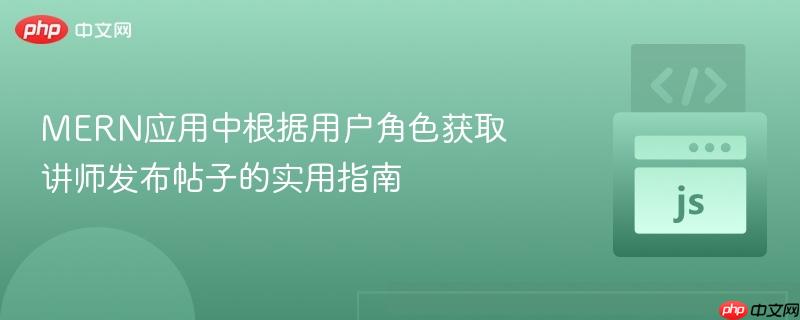
在构建mern(mongodb, express.js, react, node.js)应用时,数据模型的设计至关重要。本场景涉及post(帖子)和user(用户)两个核心模型。post模型记录了帖子的内容、标题、标签等信息,并通过user字段关联到其发布者——一个user模型的objectid。user模型则包含了用户的基本信息,如姓名、邮箱、密码哈希,以及一个关键的role字段,用于区分用户身份(例如student或instructor)。
以下是本案例中使用的Post和User模型定义:
Post 模型 (PostSchema)
import mongoose from 'mongoose';
const PostSchema = new mongoose.Schema(
{
title: {
type: String,
required: true,
},
text: {
type: String,
required: true,
unique: true,
},
tags: {
type: Array,
default: [],
},
viewsCount: {
type: Number,
default: 0,
},
user: { // 关联到 User 模型
type: mongoose.Schema.Types.ObjectId,
ref: 'User',
required: true,
},
imageUrl: String,
comments: [{ type: mongoose.Schema.Types.ObjectId, ref: 'Comment' }],
},
{
timestamps: true,
},
);
export default mongoose.model('Post', PostSchema);User 模型 (UserSchema)
import mongoose from "mongoose";
const UserSchema = new mongoose.Schema({
fullName: {
type: String,
required:true,
},
email: {
type: String,
required:true,
unique: true,
},
passwordHash: {
type: String,
required: true,
},
role: { // 定义用户角色,枚举类型
type: String,
enum: ["student", "instructor"],
required: true,
},
avatarUrl: String,
},
{
timestamps: true,
});
// 可选:定义实例方法用于角色检查
UserSchema.methods.isStudent = function () {
return this.role === "student";
};
UserSchema.methods.isInstructor = function () {
return this.role === "instructor";
};
export default mongoose.model('User', UserSchema);问题在于,我们无法直接在PostModel.find()查询中通过role: "instructor"来过滤帖子,因为Post模型本身并没有role字段。role字段属于User模型,而Post模型通过user字段引用了User模型。因此,我们需要一种方法来“跨模型”进行查询。
要获取所有由讲师发布的帖子,我们需要执行一个两阶段的查询过程:
以下是实现这一逻辑的控制器代码示例:
import PostModel from '../models/Post.js'; // 假设你的Post模型路径
import UserModel from '../models/User.js'; // 假设你的User模型路径
export const getAllByTeacher = async (req, res) => {
try {
// 1. 获取所有角色为“instructor”的用户ID
const instructors = [];
const users = await UserModel.find({ role: "instructor" });
users.forEach(u => { // 使用 forEach 或 map 收集 ID
instructors.push(u._id);
});
// 2. 根据讲师ID查询帖子
// 使用 $in 操作符查找 user 字段在 instructors 数组中的所有帖子
const posts = await PostModel.find({ user: { $in: instructors } })
.populate('user') // 填充用户数据,以便获取讲师的详细信息
.exec();
res.json(posts);
} catch (err) {
console.error(err); // 打印详细错误信息便于调试
res.status(500).json({
message: '无法获取讲师帖子', // 更具体化的错误信息
});
}
};export const getAllByTeacherAggregated = async (req, res) => {
try {
const posts = await PostModel.aggregate([
{
$lookup: {
from: 'users', // 目标集合名 (通常是模型名的复数小写)
localField: 'user', // Post模型中关联的字段
foreignField: '_id', // User模型中被关联的字段
as: 'userDetails' // 输出的字段名
}
},
{
$unwind: '$userDetails' // 将数组形式的 userDetails 拆开
},
{
$match: {
'userDetails.role': 'instructor' // 过滤出角色为讲师的帖子
}
},
{
$project: { // 选择需要返回的字段,并可以重命名
_id: 1,
title: 1,
text: 1,
tags: 1,
viewsCount: 1,
imageUrl: 1,
comments: 1,
createdAt: 1,
updatedAt: 1,
user: '$userDetails' // 将userDetails作为user字段返回
}
}
]);
res.json(posts);
} catch (err) {
console.error(err);
res.status(500).json({
message: '无法获取讲师帖子 (聚合查询)',
});
}
};聚合查询在某些场景下更为强大和高效,但其语法相对复杂。对于本教程的简单需求,两步find查询已足够清晰和有效。
通过本教程,我们学习了如何在MERN应用中,利用Mongoose的find和$in操作符,结合populate功能,高效地根据用户角色来筛选和获取关联数据。这种两阶段的查询方法是处理跨模型数据关联查询的常见且直观的模式。同时,我们也探讨了聚合查询作为更高级的替代方案,以及在实际开发中需要考虑的性能优化和错误处理等关键点。掌握这些技术将有助于您构建更加灵活和强大的MERN应用。
以上就是MERN应用中根据用户角色获取讲师发布帖子的实用指南的详细内容,更多请关注php中文网其它相关文章!

每个人都需要一台速度更快、更稳定的 PC。随着时间的推移,垃圾文件、旧注册表数据和不必要的后台进程会占用资源并降低性能。幸运的是,许多工具可以让 Windows 保持平稳运行。

Copyright 2014-2025 https://www.php.cn/ All Rights Reserved | php.cn | 湘ICP备2023035733号